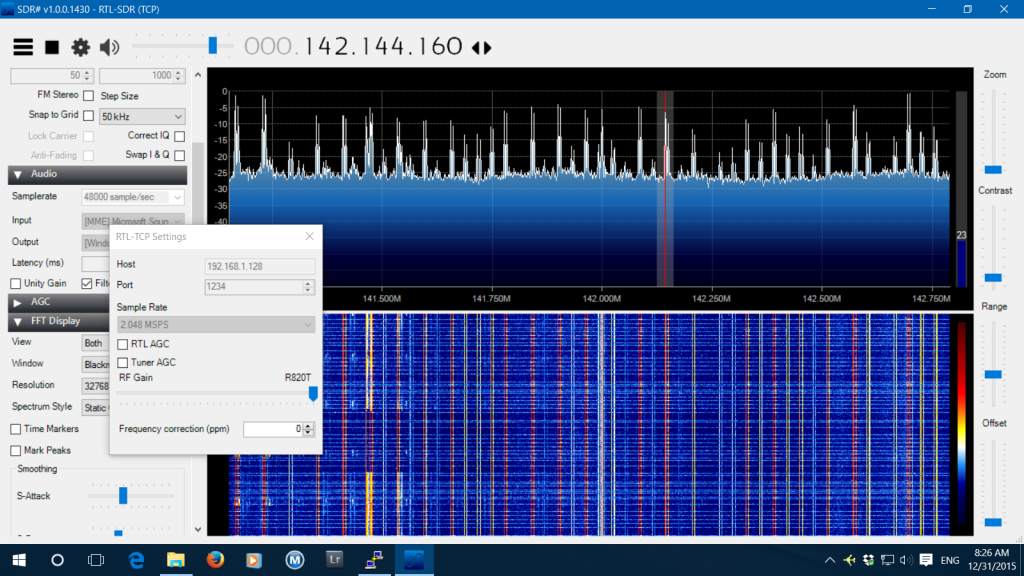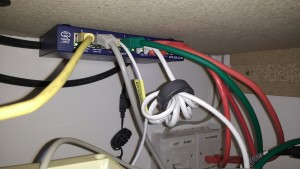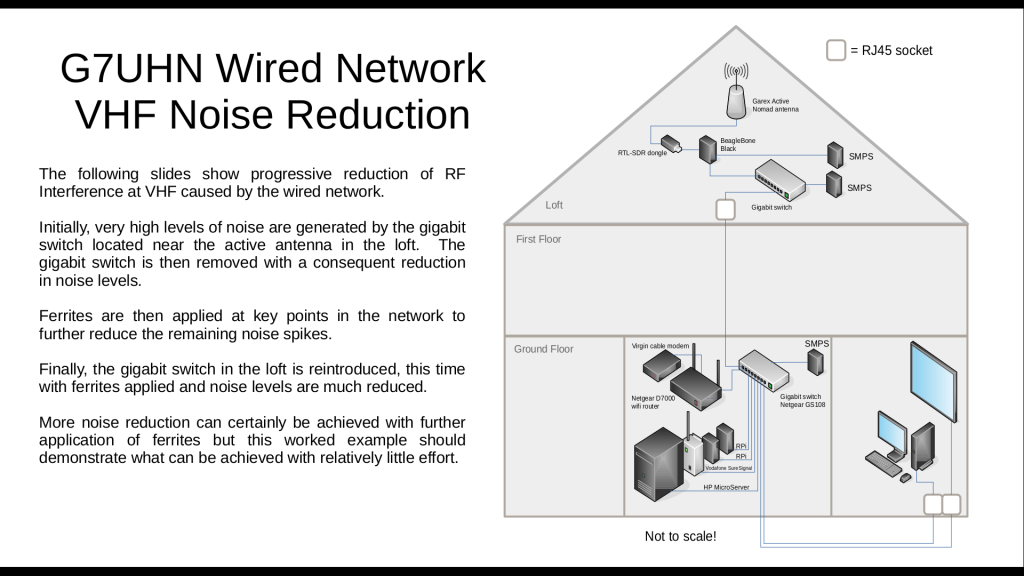I’m carrying out some changes to the general-coverage receiver setup here at G7UHN. This activity has led me to look at the electrical noise produced in the local environment (i.e. my house!) and take some steps to minimise the locally produced RFI. This page is intended to show the surprisingly strong effect of placing ferrites at key points on my wired Ethernet network and I hope it might be useful to others.
My setup here at home is limited by a small garden, family constraints and a desire to minimise visual impact so remote-controlled radios and loft antennas are typical of my operation. At the time these measurements were made, my V/UHF antenna was a Garex Active Nomad installed in my loft space. This was used to feed a low-cost RTL R820T2 SDR dongle which was then connected to the home network by a BeagleBone Black computer. My preference is to use wired networking where possible for better streaming performance for the radio applications and, with multiple computing devices around the house, a few gigabit network switches are essential to my setup. OK so perhaps it’s not the greatest idea to install a gigabit switch within a few metres of an active wideband antenna in the loft but if you read on you will see the RFI can be quite effectively mitigated…
This activity was guided by the excellent notes provided by Joel Harrison W5ZN.


On all of the SDR screenshots on this page the receiver is a simple RTL R820T2 SDR dongle (from rtl-blog.com) fed by a Garex Active Nomad antenna hung from the peak of the loft. The gain of the RTL dongle is set to maximum for repeatability across the measurements and also to maximise visibility of the interference while going through the fault finding exercise. My current interest is in 137 MHz weather satellite reception and 144 MHz amateur activity and the spectrum around 142 MHz seemed to have a particularly bad noise problem so the focus has been to reduce the noise there.
In the main, the ferrites applied are Fair-Rite #43 material and available from the RSGB shop. They are large enough to get the suggested 7 turns of standard UTP Ethernet cable through. Towards the end of the experiment I chucked a few cheap ferrite beads on some of the remaining PSU cables in the loft and they also had an effect, further reducing some of the noise peaks.
The following slides have been put together so that you can step through each stage of the noise reduction exercise and see what changes have been made to the network as the RFI is reduced. The slideshow should launch automatically and you should be able to step you way forward and back through the slides with your arrow keys:
G7UHN network noise reduction slideshow (PDF)
The two gigabit switches after application of ferrites:


Conclusions
Both the application of ferrites and the use of linear power supplies to replace switch-mode power supplies in key areas can have a dramatic effect on RFI at VHF. This example starts with a pretty extreme scenario of a network switch in close proximity to an indoor active antenna but, with selective application of ferrites, the RFI is reduced to workable levels:
- Noise floor reduced by ~20 dB
- Ethernet noise spikes (‘birdies’) reduced by >30 dB
- Swapping the network switch switch-mode power supply for a linear power supply improves things further (the Netgear switches I’m using work from 12VDC making it easy to find affordable linear power supplies)
Note that I don’t believe the TP Link switch is necessarily inferior to the Netgear switch (swapped in Slide 07), simply that the internal power circuits produce switching mode noise at different frequencies and by using the same brand/series of switch across the house the interference peaks are aligned and cause less visual stress on the spectrum/waterfall.
If you’re interested in RFI around the house you might also be interested in a previous post on this site – a major source of RFI in my house is a stretch-wire lighting system. Turning these lights on raises the noise floor across HF, VHF and UHF by about 10 dB per rail (so 20 dB of extra noise if all the lights are on!). So far I haven’t done anything to address this other than turn those lights off when I’m playing radio but it’s something I may look at in the future.
The story doesn’t really end here and I have since made further changes to my network and receiver setup but hopefully these examples will be useful in showing the kind of reductions in RFI that can be made quite easily and be helpful to you in your own noise reduction efforts. Enjoy!

